Hot Projects
CryptoHeap Releases In-Depth Advisory on Crypto Staking with Servi… | EVM News


CryptoHeap, a prominent player in the cryptocurrency staking industry, has published an insightful advisory titled “What is Crypto Staking, and How Does it Work with a Service Provider?” This guide aims to demystify the concept of crypto staking, elucidate its workings, and demonstrate how service providers can enhance the staking experience, making it more accessible and secure for everyone.
What is Crypto Staking?
Crypto staking involves holding and delegating an amount of cryptocurrency to support the security and governance of a blockchain. This process is fundamental to the Proof of Stake (PoS) consensus mechanism, which many modern blockchains, such as Ethereum, Solana, and Cardano, use to validate transactions and secure the network.
When users stake their coins, they contribute to the blockchain’s security and transaction validation process, earning rewards in return. Unlike Proof of Work (PoW) systems like Bitcoin, which rely on computational power for transaction validation, PoS relies on validators holding and staking their coins.
Staking usually requires a lockup period during which the staked coins are less liquid. Users must unstake their coins and wait for the blockchain’s specific unbonding period before they can access their staked crypto.
Proof of Stake (PoS) and Delegated Proof of Stake (DPoS)
Proof of Stake (PoS) significantly reduces energy consumption and makes the network more environmentally friendly compared to PoW. Validators in PoS are selected based on the number of coins they hold and stake, combined with randomization or other mechanisms to ensure fairness and security. For example, Ethereum uses a system where validators are selected randomly from a pool of candidates.
Delegated Proof of Stake (DPoS) adds a layer of representation, where stakers delegate their coins to trusted validators who perform network operations on their behalf. Participants vote for a small number of delegates, and the voting power is based on the number of coins staked. Examples of DPoS systems include EOS and Tron.
Staking Pools
Staking pools allow small investors to combine their resources, increasing their chances of earning rewards. The rewards are distributed proportionally among pool members based on their contributions. Staking pools are beneficial for small investors who may not have enough coins to stake independently but want to participate in the staking process.
Benefits of Crypto Staking
Staking offers several benefits, including earning passive income, maintaining network security, and promoting decentralization. Stakers earn rewards in the form of additional cryptocurrency for their contribution to the network, providing a way to generate passive income.
Staking also helps secure and decentralize the network, ensuring the blockchain remains robust and resistant to attacks. It generally requires less technical knowledge and resources compared to PoW mining, making it accessible to a broader range of participants. Additionally, staking is considered a more energy-efficient and environmentally friendly alternative to PoW mining.
Restaking
Restaking allows users to use their already staked cryptocurrency to secure additional networks or services, earning more rewards and increasing the overall security of the blockchain ecosystem.
Staking with a Service Provider
Platforms like Allnodes handle the technical aspects of staking on behalf of users, making it easier for non-technical investors to participate. These platforms offer user-friendly interfaces, ensuring that even beginners can start staking with ease.
Allnodes, for instance, provides a secure environment for staking, employing advanced security measures and non-custodial services to ensure users retain control of their coins. The platform guarantees a high uptime SLA, innovative tools, and broad protocol support, enhancing the staking experience and providing additional functionalities that benefit users.
How to Stake with Allnodes
Staking with a service provider like Allnodes involves creating an account, choosing a blockchain protocol, delegating your stake, and monitoring your rewards through the platform’s dashboard. The platform also offers restaking features to compound rewards automatically, ensuring continuous earnings growth without requiring manual intervention.
Comprehensive Staking Packages
CryptoHeap offers a range of staking packages tailored to meet diverse investment goals, providing attractive returns and robust security. These packages include some of the best crypto staking coins, ensuring that investors can find the best crypto to stake in 2024. Here are the available packages:
-
Arbitrum: $100 for 1 day; $2 daily rewards.
-
Toncoin: $200 for 1 day; $4 daily rewards.
-
Sui: $600 for 6 days; $6 daily, $36 total, $6 referral rewards.
-
Polygon: $1,500 for 8 days; $16.50 daily, $132 total, $18 referral rewards.
-
Cardano: $5,000 for 12 days; $60 daily, $720 total, $70 referral rewards.
-
Ethereum: $8,000 for 16 days; $104 daily, $1,664 total, $128 referral rewards.
-
Tron: $10,000 for 20 days; $130 daily, $2,600 total, $170 referral rewards.
-
Solana: $15,000 for 25 days; $210 daily, $5,250 total, $300 referral rewards.
-
Bitcoin: $30,000 for 30 days; $480 daily, $14,400 total, $690 referral rewards.
-
Chainlink: $50,000 for 40 days; $950 daily, $38,000 total, $1,650 referral rewards.
-
Cosmos: $100,000 for 50 days; $2,100 daily, $105,000 total, $3,800 referral rewards.
-
Uniswap: $150,000 for 55 days; $3,750 daily, $206,250 total, $6,750 referral rewards.
These comprehensive staking plans make CryptoHeap a top choice for investors looking to capitalize on the best staking crypto options.
CryptoHeap’s new advisory on crypto staking provides valuable insights into the process and benefits of staking, highlighting how service providers can simplify and enhance the experience for investors. This guide is an essential resource for anyone interested in crypto staking, offering clear explanations and practical advice.
For more information about CryptoHeap’s services and upcoming enhancements, visit the official website at /.
Media Contact Details
Contact Name: Salvage Warwick
Contact Email: [email protected]
Address: 250 NE 25th St Apt 910, Miami, FL 33137, USA
City/Country: Miami, FL, USA
Website: https://cryptoheap.com
Disclaimer: The information provided in this press release is not a solicitation for investment, nor is it intended as investment advice, financial advice, or trading advice. It is strongly recommended you practice due diligence, including consultation with a professional financial advisor, before investing in or trading cryptocurrency & securities.
Hot Projects
Band Protocol Price Eyes 276% Jump As Bullish Wedge Pattern Emerge… | EVM News
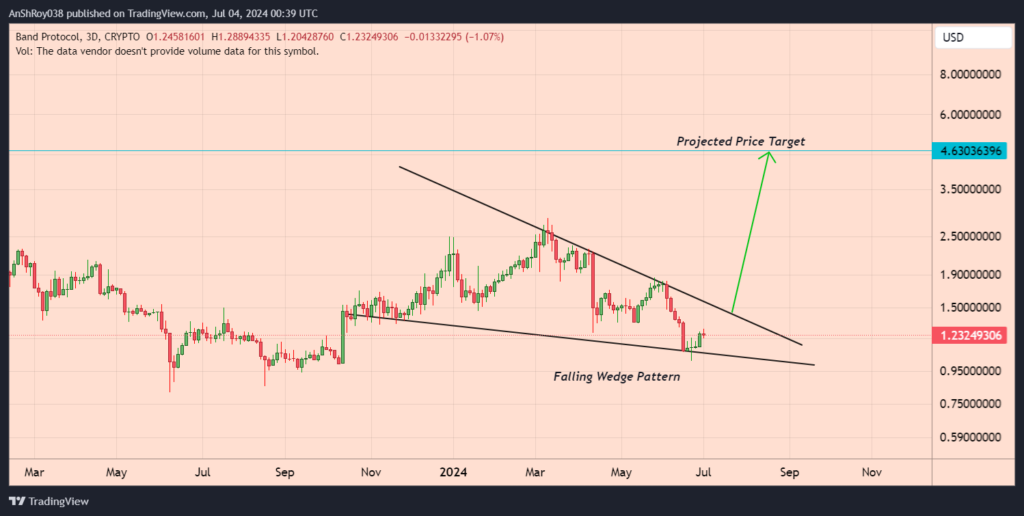

NOIDA (CoinChapter.com)—Band Protocol (BAND) made significant advances in the crypto sector, and recent developments highlight the project’s commitment to expanding.
Unconfirmed social media posts suggest that Synthetix could be working on integrating Band Protocol. If true, partnership news could help BAND price confirm a bullish technical pattern.
BAND Price Formed Bullish Pattern
The Band Protocol token formed a bullish technical pattern called the ‘falling wedge.’
Bullish news, such as Bond Protocol’s making a new partnership or integrating with other projects, could help the project’s token confirm the pattern.
A falling wedge pattern features a pair of converging trend lines connecting lower highs and lower lows, forming a narrowing shape that slopes downward.
The pattern typically suggests that an asset’s price, while consolidating in a downtrend, is losing bearish momentum and preparing for a potential reversal to the upside. Typically, a breakout occurs in the direction of the overall trend, which, for a falling wedge, is upward.
To estimate the price target of a falling wedge pattern, traders measure the widest part of the wedge at the beginning of the formation. They then project this distance upward from the breakout point to set a potential target.
An accompanying increase in trading volume can further confirm the reliability of the breakout. Higher volume during the breakout suggests stronger market conviction, supporting the likelihood of a successful price reversal.
According to the rules of technical analysis, the Band Protocol token price could rally over 276% to reach the pattern’s theoretical price target near $4.6.
It is unlikely the token would rally to the projected price target immediately after confirming the pattern, but breaking out of the wedge setup could attract more buying pressure, helping the token continue its rally till profit booking puts the brakes on the run.
BAND Bulls Struggling With 20-Day EMA
BAND price climbed above its 20-day EMA (red wave) dynamic resistance as the token entered July. However, July 3’s nearly 6% drop forced the token’s price back below the EMA resistance, suggesting bears aggressively defend the supply zone near the 20-day EMA.

Bulls have their task cut out, with the token starting July 4 with minor gains. Flipping the EMA resistance with good volumes would certainly help the BAND price’s cause, helping the token rally to the resistance near $1.34.
A break above immediate resistance might see the Band Protocol token’s price target the 100-day EMA (blue wave) resistance near $1.5.
On the other hand, if BAND price fails to rally, the token could drop to the support levels near $1.14 and $1.05 before recovering.
The RSI for BAND remained neutral, with a score of 45.56 on the daily charts.
Hot Projects
Litecoin Price Tests Critical Support: Will the Bulls Prevail? | EVM News
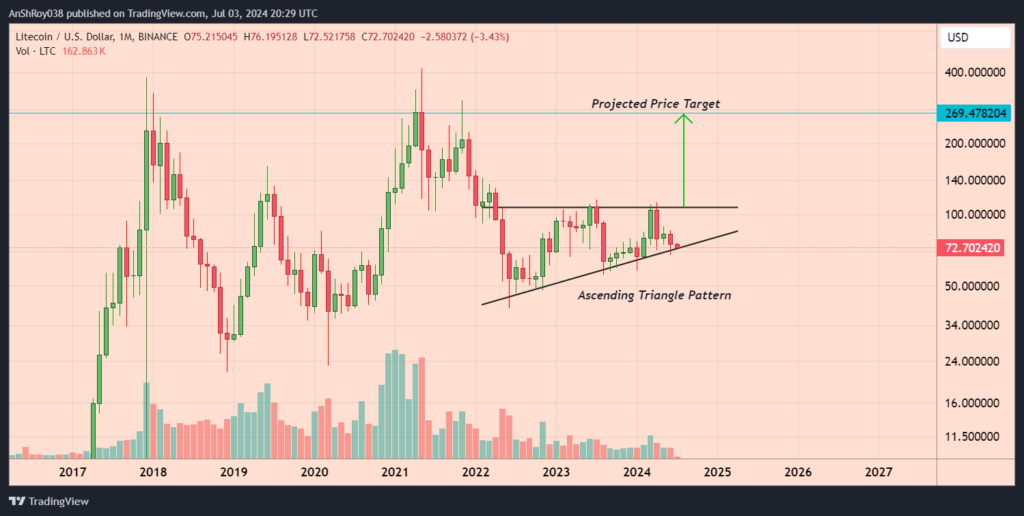

NOIDA (CoinChapter.com)— Litecoin price ended June down by nearly 10%, and so far, July has not been very kind to the blockchain platform. LTC bulls have failed to convert a recent surge in network activity into a bullish cue for the token.
However, a technical setup might help avoid LTC price more bloodshed, if the bulls manage to avoid invalidating the pattern.
Litecoin Price Testing Support Of Bullish Setup
The Litecoin token’s price has formed a bullish technical setup called the ‘ascending triangle.‘
The token’s price are currently testing the ascending trendline of the pattern. A rebound from here could infuse confidence in the token’s rally, attracting more buyers expecting a bullish breakout.
Under technical analysis, an ascending triangle pattern emerges when a horizontal trendline connects swing highs and an ascending trendline connects swing lows. The pattern indicates a consolidation period where the buyers gradually gain strength against a consistent level of resistance.
Volume analysis is critical, as it helps to validate the breakout’s strength. Typically, as the price action approaches the triangle’s apex, the volume tends to decrease, reflecting a period of reduced trading activity and uncertainty.
When the trendlines converge, creating a narrowing price range, buyers often enter the market in anticipation of a breakout. Ideally, the breakout occurs above the horizontal resistance line, accompanied by a significant increase in trading volume.
The surge in volume is a key indicator that the breakout is robust and likely to sustain.
According to the rules of technical analysis, the price target for a breakout is equal to the triangle’s height at its thickest point. If the bullish pattern pans out, the theoretical price target for LINK is near $269.5, a spike of 267% from current levels.
LTC price Fails To Conquer EMA Resistance
Litecoin price has failed to move above the 20-day EMA (red wave) dynamic resistance since June 8, with prices dropping nearly 6% to a daily low near $72 on July 3. The downtrend suggests bears are booking profits near $72.
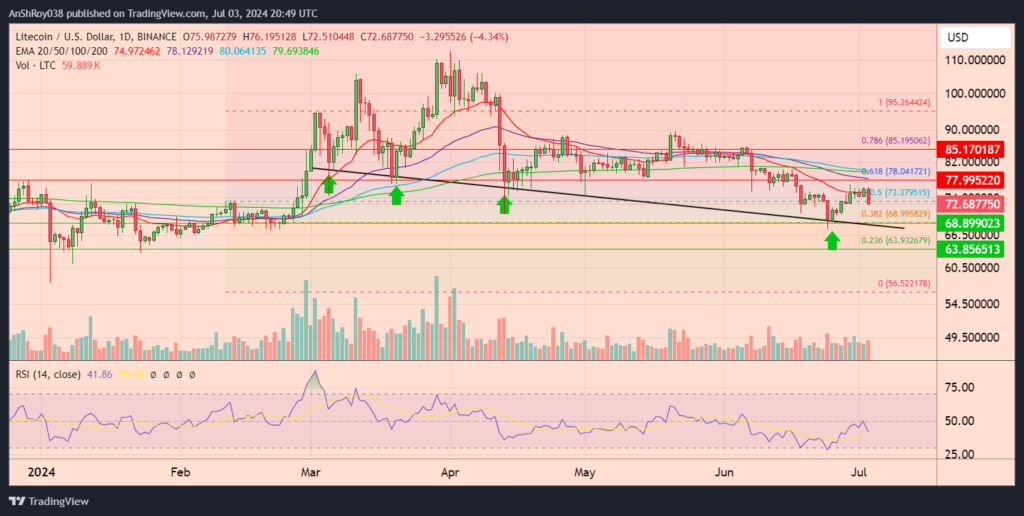
A sustained rally from here would likely see Litecoin price rally to the 50-day EMA (purple) resistance near $78. Moreover, flipping the above immediate resistance level could help LTC price rise to the resistance near $85.
On the other hand, if prices continue to fall, Litecoin could end up invalidating the pattern, inviting more bearish sentiment and likely ending up at the support level near $69. Failure of the immediate support could force LTC price to test the support near $63.8 before recovering.
The RSI for LTC remained neutral, with a score of 41.86 on the daily charts.
Hot Projects
Ethereum and Solana Battle for Dominance in Layer 1 … | EVM News


NAIROBI (CoinChapter.com)—Thanks to some recent developments, the rivalry between Ethereum and Solana has intensified. Ethereum remains a powerhouse in the Layer 1 blockchain sector and DeFi, but Solana is gaining traction with significant economic activity and growing market share.
CoinMarketCap data shows Ethereum commanding 62% of the $695 billion market cap in the smart contract space. The network also dominates revenue, securing 70% of Layer 1 income. Ethereum’s stronghold extends to the DeFi sector, with Ethereum doubling its total value locked (TVL) since the start of the year.
BNB Chain follows with $85 billion in the smart contract space, while Solana holds $59 billion. In terms of DeFi TVL, BNB Chain contributed $5 billion in the second quarter, and Solana contributed $4 billion.
Solana Gains Traction, but Ethereum Holds Strong
While Solana shows growth in certain metrics, Ether remains the dominant force. Mert Mumtaz, CEO of Helius Labs, noted that Solana’s economic activity surpasses Ethereum at times, driven by higher MEV and priority fees.
According to DefiLlama, despite Solana’s growth, Ethereum’s DeFi TVL stands at $57.36 billion, compared to Solana’s $4.5 billion. Tron and BNB Chain occupy the middle ground with $7.7 billion and $4.8 billion, respectively. Ethereum’s continued dominance in the Layer 1 sector, despite the rise of Layer 2 solutions, highlights the blockchain’s demand.

Ryan Connor, a researcher at Blockworks, posted on X about the strengthening case for the SOLETH relative value trade. Connor noted Ethereum’s market cap and price-to-sales ratio are near cycle highs, while Solana’s price-to-sales ratio is at all-time lows.
He emphasized Ethereum’s revenue decline and Solana’s growing market share and revenue, raising questions for traditional finance (TradFi) investors about Ethereum’s valuation.

Ethereum’s trailing 1-month price-to-sales (P/S) ratio fluctuated significantly, reaching a recent level of around 220, whereas Solana’s dropped to 67. Furthermore, Solana’s blockspace profitability has seen a sharp rise, reaching nearly $80 million in emissions.
In contrast, Ethereum’s blockspace profitability peaked at around $2 billion in mid-2021 but has since stabilized.

Additionally, the t30d DEX volume market share chart shows ether holding a majority share, although Solana has been increasing its presence, now capturing around 30%. Though the data supports the narrative of Solana’s growing influence, it also emphasizes Ethereum’s sustained leadership.
SOL & ETH Price Performance and Market Outlook
Price performance data reveals significant insights. As of July 3, 2024, Ethereum is priced near $3,280, experiencing a 5% decline in the past 24 hours and a nearly 3% decrease over the past seven days. Ethereum’s market cap stands at $395.8 billion, with a trading volume of $10.4 billion.
Solana is priced around $142, reflecting a 5.68% decrease in the past 24 hours but a 3.68% increase over the past seven days. This price increase aligns with Solana’s rising market activity, while Ethereum’s relative stability reflects its entrenched market dominance.
-

 Latest News3 months ago
Latest News3 months agoCrypto New Media Decrypt Warns Against $Decrypt Token Airdrop Scam | EVM News
-

 Latest News4 months ago
Latest News4 months agoCeτi AI Announces Successful Launch Of Revolutionary Decentralized AI Infrastructure Token | EVM News
-
Hot Projects4 months ago
Fetch AI Outshines in AI Token Dominated Gainers but This New AI A… | EVM News
-

 Latest News3 months ago
Latest News3 months agoJapanese Telecom Companies Jump Into Crypto Sector, Plans To Launch Crypto Wallet | EVM News
-

 Latest News4 months ago
Latest News4 months agoBitcoin Dogs Sets A New Standard In Crypto Amidst Bitcoin Surge | EVM News
-
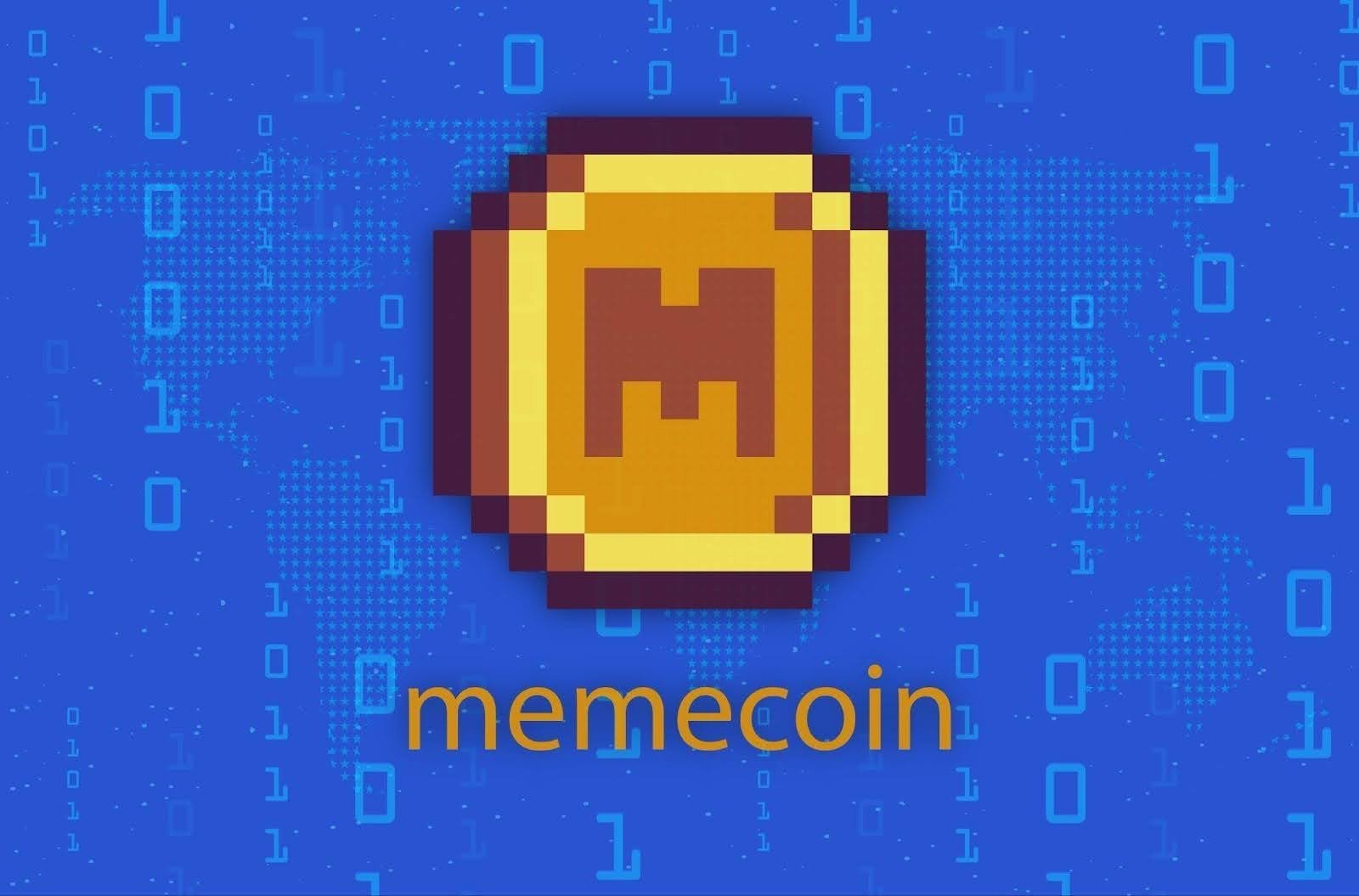
 Latest News1 month ago
Latest News1 month agoTelegram Founder Receives Donations In Notcoin Worth $7 Million, Rising Appeal For New Memecoin | EVM News
-

 Latest News2 months ago
Latest News2 months agoBC.GAME Secures New Curacao LOK License, Enhancing Legal Compliance And Global Reach | EVM News
-
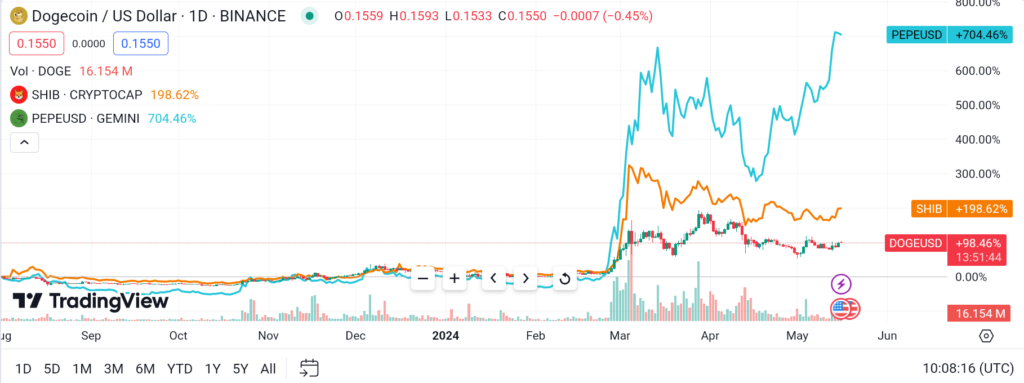
 Hot Projects2 months ago
Hot Projects2 months agoDogecoin is Severely Underperforming New Memecoins This Year — Sho… | EVM News


